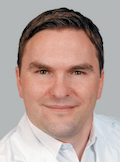Article
Brain activity in OAB patients characterized in study
Author(s):
Preliminary findings of a Swiss study revealed that the brain activity associated with the desire to void in response to the automated, repetitive filling and distention of the bladder with body warm saline differed greatly between healthy patients and patients with non-neurogenic overactive bladder.
Munich, Germany-Preliminary findings of a Swiss study revealed that the brain activity associated with the desire to void in response to the automated, repetitive filling and distention of the bladder with body warm saline differed greatly between healthy patients and patients with non-neurogenic overactive bladder (NNOAB).

Dr. WalterOAB is characterized by urinary urgency and frequency. Supraspinal control and specifically sensory processing become altered in patients with OAB, according to first author Matthias Walter, MD, research fellow in neuro-urology at the University of Zürich, Balgrist University Hospital, Zürich, Switzerland.
The study, which was presented at the European Association of Urology annual congress in Munich, Germany, included 24 right-handed female participants, of whom 12 had a diagnosis of OAB and 12 were healthy subjects who were matched for age and gender. This was a block design functional magnetic resonance imaging (fMRI) study that acquired neuroimaging data with the use of a 3 Tesla MR scanner. The scan paradigm comprised automated, repetitive bladder filling of 100 mL body warm saline within 15 s.
The patients were catheterized and their bladders were pre-filled until a persistent desire to void was reported from each subject. Using SPM8, the blood-oxygenation-level dependent signal change during bladder filling was compared to the level at rest; ie, the pre-filled bladder.
Dr. Walter and his colleagues observed bilateral activation in the frontal and prefrontal areas in healthy subjects, including in the inferior frontal gyrus pars triangularis (BA45), pars orbitalis (BA47), and medial frontal gyrus (BA10 and 46).
Activation patterns in NNOAB patients included the right hemisphere: insula, supramarginal gyrus (BA40), rolandic operculum (BA44), and the postcentral gyrus (primary somatosensory cortex); the left hemisphere: superior frontal gyrus (BA8), caudate, angular gyrus (BA39); and thalamus, as well as bilateral activation patterns: middle cingulate cortex (BA24).
Next: No group differences on whole-brain analysis
No group differences on whole-brain analysis
Furthermore, no group differences were detected on whole-brain analysis. The regions of interest (ROI) analyses revealed significantly stronger activations in the right posterior insula, left middle cingulate cortex, and left cerebellum for NNOAB patients compared to healthy subjects.
Read: Data weigh neuromodulation’s impact on QoL at 3 years
“These differences might reflect the abnormal and unpleasant sensation of urinary urgency and fear of leakage, since both the right dorsal insula and the middle cingulate cortex have been associated with the processing of complex somatosensory information involving emotions and sensory discomfort,” Dr. Walter explained.
The second-level random effects analysis included a sample t-test for each group. Within-group results are shown at a voxel-threshold at p=.05 familywise error rate (FWE) and at p<.001 using the false discovery rate correction, with a strict cluster threshold correction of p<.05 (cluster extend: k >42 voxels) to adjust for multiple comparisons using Monte Carlo simulations.
For group comparisons, whole-brain analyses as well as ROI analyses were computed. The whole-brain analysis was conducted for a comprehensive overview. The ROI approach was performed to explore regional differences between both groups. Thus, the ROIs were included as a mask in order to restrict the voxel-by-voxel statistical analysis (including FEW correction) to pre-specified brain areas. ROIs were generated using the WFU Pickatlas.
“fMRI is a powerful tool to investigate the supraspinal network of lower urinary tract control in response to distinct stimuli such as repetitive bladder filling,” Dr. Walter said.
Have you read:
VUR: What goes into parents’ treatment choices
Data reveal big changes in PCNL use in U.S.
The season for meetings: Why I attend them (and why you should too)
Subscribe to Urology Times to get monthly news from the leading news source for urologists.
Newsletter
Stay current with the latest urology news and practice-changing insights — sign up now for the essential updates every urologist needs.














